
CMS offer one stop solution including materials, injection mold making, manufacturing, surface treatment, inspection test, packaging, assembly, report and flexible delivery (factory delivery, port delivery or door to door). We also offer some product solutions for mixed processes, like in-mold decoration (IMD), in-mold labeling (IML), insert molding, outsert molding, overmolding and PEI resin injection molding.
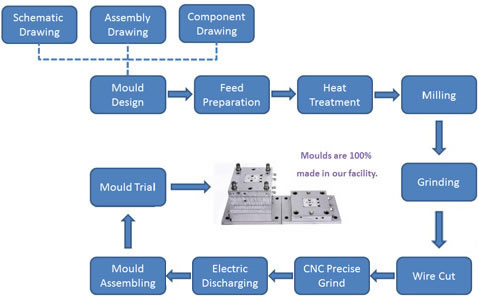 Overview:
Overview:
Parts Design (client may provide completed 3D files)
The tooling process begins with a completed and checked part design. CMS can optionally optimize your design for Design for Asian Manufacturing (TM) before tooling in order to lower your costs and ensure that your design will work well with Asian processes.
Parts Prototyping (if necessary)
If you would like to validate your parts design with a machined piece that you can see and feel, CMS can use Computer Numerical Control (CNC) techniques to prototype your parts.
Tool Design
At this stage the tool is designed, using the information from your completed Tooling Information Worksheet.
Tool Check and Mold Flow Analysis
The tool design is validated for correctness.
Tool Fabrication (including use of Computerized Numerical Control (CNC) and Electrical Discharge Machining (EDM) technologies)
The tool is precisely fabricated according to the validated design.
First Shots To Client
Once the injection molds are made, the first test shot samples will be sent out soon after via international courier. Once sent, these usually take around 2-5 days to arrive.
Tool Modifications and Texturing
At this stage CMS completes the tool and makes any required changes to bring the tool into the approved spec. Changes made to bring the tool to spec (specifically excluding design changes, which are always charged for) are made free of charge by CMS.
At this stage, texturing also takes place, which is normally the last stage before mass production.
Mass Production Run or Export
At this stage parts are produced and delivered to the customer, or the tool is released for export use.
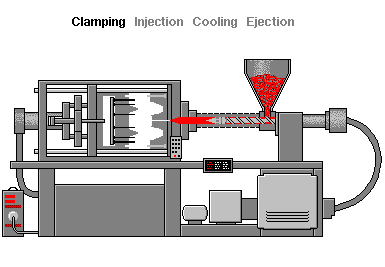
Molding begins with tooling. No matter how good the design, if the tooling is not up to the task, the quality of the parts will suffer.
The Molding Machine
Achieving consistent dimensions and quality requires up-to-date molding machines, operating to specifications, with precise position and pressure control capabilities. The basic construction of a molding machine is fairly straightforward:
Material is fed in through a hopper into a screw and barrel where it is heated to a molten condition. The melt is then injected under high pressure into the mold while the mold is held closed with the high force of a toggle or hydraulic ram. The goal is to melt resin in a very uniform and repeatable fashion, inject it into the mold under very precise and repeatable pressure conditions, and hold the steel temperatures in the entire flow system very stable. After the molten plastic is solidified, the mold is opened and the gear is ejected. It then continues to cool in the open air.
There are many handling and pre-processing requirements for injection molding materials. Engineering polymers quite often must be dried to a specific dew point prior to use. When parts are made, runners are formed that some shops regrind and put back in the melt. This quite often raises more quality concerns than the slight savings in material expense may justify, and CPIM uses only virgin material.
Injection
The method of injecting the plastic into the mold is very important. In most cases the plastic should be injected under high pressure very quickly in order to maintain the good characteristics of the melt completely during injection. As the mold cavity fills, the injection pressure should be held at the same high value and the speed of injection slowed to maintain that pressure. At the moment when the part is filled, and the mold machine switches over from injection to a pack & hold condition, the plastic melt is held at the same high pressure. This pressure is held for as long as it takes to freeze the gates and achieve the highest weight possible for the molded part. Below is a graphic image of the pressure and fill patterns of a typical plastic molded part.
Other Processes of Injection Molding
In-Mold decoration also known as IMD injection mold is one of the most popular technique for surface decoration. It is widely used in the decorations for household appliances, control panels, car dashboard, air conditioner face panels, cell phone covers and lens, washing machines, fridges, and so on.
Nowadays, IMD injection molding has greatly replaced the old school multi-colored outer surface printing techniques, such like pad printing, painting, silk printing and electronic plating. It is more environmental friendly and it will last longer since it is actually beneath the surface, so it cannot get scratched or worn off.
Applications of In-Mold Decoration:
1. Household Appliances: refrigerators, air conditioners, microwaves, ovens, washing machines, and all the decorations for control panels.
2. Automobile Industry: car dashboard, lights covers, inside sign panels.
3. Electronics Industry: laptops, mobile phones, digital cameras, keyboard and mouse and all other related surface decoration.
4. Other application areas such like toys, sporting tools, cosmetics packaging boxes and gift boxes.
 |
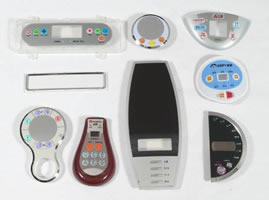 |
 |
 In-mold labeling also known as IML injection molding is one of the IMD processes. IML only refers to put the pre-printed label inside the mold cavity, and then inject or blow the resin material over it. After this process, the label and the plastic molded part will become one combined component. This technique is widely used in the packaging industry. The main characteristic of IML is the label is located on the same surface as the plastic part. It replaces the traditional label pasting machine, lowers down the cost, and increases the package’s recoverability rate.
In-mold labeling also known as IML injection molding is one of the IMD processes. IML only refers to put the pre-printed label inside the mold cavity, and then inject or blow the resin material over it. After this process, the label and the plastic molded part will become one combined component. This technique is widely used in the packaging industry. The main characteristic of IML is the label is located on the same surface as the plastic part. It replaces the traditional label pasting machine, lowers down the cost, and increases the package’s recoverability rate.
Product appearance is nice and attractive:
The products made by IML injection molding process are contour artistic, have a smooth feeling when touching the surface, and the picture is exquisite, so it can achieve a very good visual expression. The label is closely integrated with the bottle with good adhesiveness allover the label area. In addition, the label is able to avoid the touch, scratch and contamination might caused in the process of production and transportation. The durability is long, and it will not be affected by the wet environment or gets moldy. Especially suitable for the labels and packaging appearance to demand higher commodity and cosmetics industry.
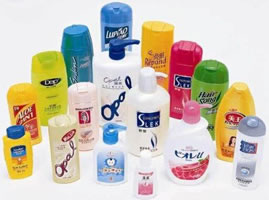 |
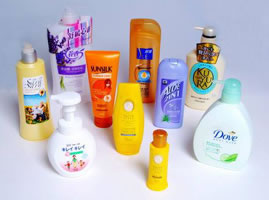 |
|
Insert molding refers to inject the plastic resin material around an insert, which is normally metal insert. Outsert molding refers to metal parts around the plastic components. Custom insert molding and outsert molding service directly by China factory. We do plastic injection mould making in house, with the 15 years experience, ISO 9001:2008 certified, stable quality and cost-effective.
1. Plastic resins can be easily formed and bent, while the metal materials are rigid, strong and heat resistant. This process can combine these two types of materials together and produce complicate and delicate plastic-metal products.
2. Specially uses the insulativity of plastics and the electrical conductivity of metals combination to produce good electrical products.
3. Multiple inserts can be added prior to production.
4. Insert types are not limited to metal only, can be cloth, paper, wire, plastic, glass, wood, coil and other electrical items as well.
5. The plastic resins will be melted first and then form together with the inserts, so the gaps around the inserts can be designed to be very small.
6. Even the inserts are fragile and can be easily damaged, such like glass, coil and electrical components, the plastic resin can still secure and seal them.
7. With the proper mold construction, the inserts can be completely sealed into the plastics.
8. Combining vertical plastic injection molding machine and mechanical arms, no matter how large the project is, the production lines can be automatic and efficient.
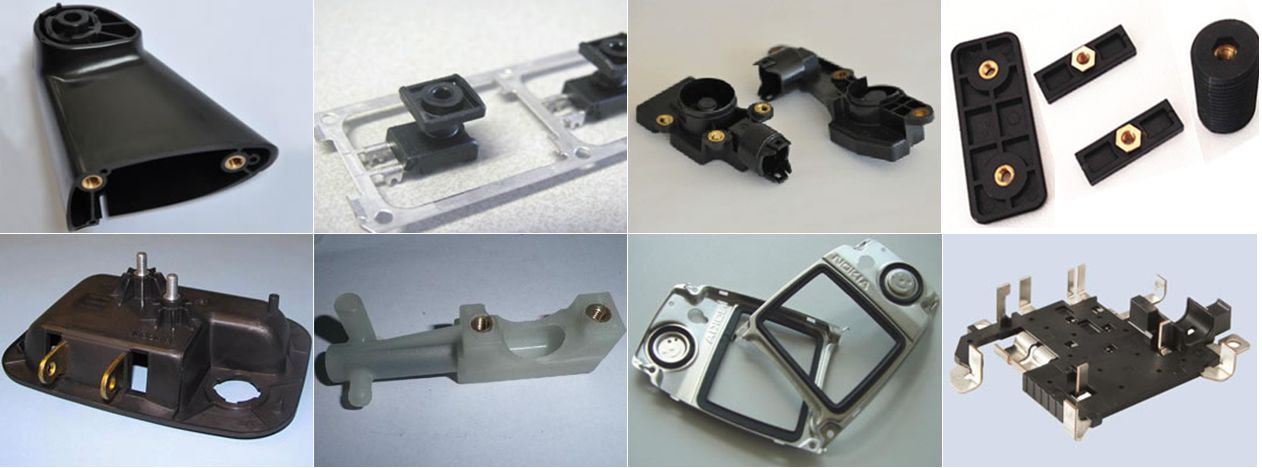
Plastic overmolding means to inject another plastic material over around an existing product, and then they will become one single unit. This is very similar to insert molding method. The two material types from these two different operation can be different in plastic overmolding process. The existing base product can be hard plastics like ABS or PP, and the secondary overmolding material can be soft material such like rubber. This normally is used as the tools handle grips, knife handle grips and pens. And the colors can be different as well.
Advantages of Plastic Overmolding:
1.Save cost and manufacturing time: If not using overmolding process, in order to bond two different materials together, an adhesive has to be used. By using the overmolding method, this secondary process can be eliminated.
2. Design benefits: Since the material types and colors can be different, the overmolding material can be soft and can be in a different color, to a certain extent, this can be the decoration to the parts, so that the design will be better off.
 |
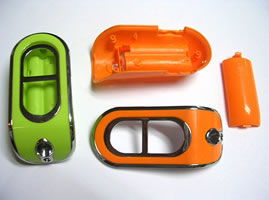 |
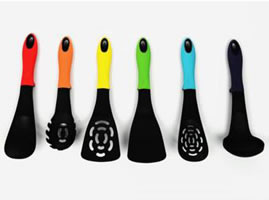 |
 |
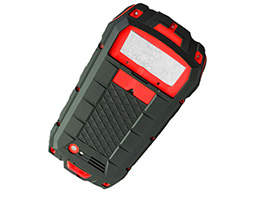 |
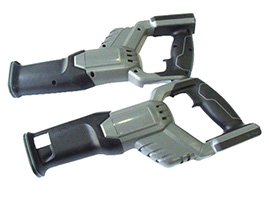 |
 |
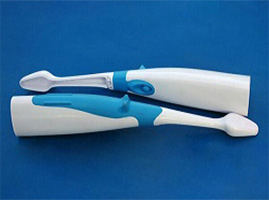 |
PEI Injection Molding
The items made by PEI injection molding process are normally in high smooth and glossy surfaces. The PEI resin is heat resistant and has an excellent electrical property, so the PEI items mostly will be used in the high temperature and electrical applications.
Applications of PEI Injection Molding:
1. High temperature applications include microwave containers and trays, temperature sensors, insulation panels, lamps and lights with high power volts.
2. Electrical applications include circuit boards and coils, and general conductive connectors.
3. PEI injection molded products are being used in medical industry as well, such like surgical instruments, dental appliances, optical lens with high precision, surgical trays and clamps, and so on.
Parts and Mold Design for PEI Injection Molding:
1. Since the physical property of PEI resin material is excellent, when designing items made in PEI, this should be taken as the main advantage. However, items better do not have sharp corners and the wall thickness cannot be very thin. In addition, the wall thickness for entire part needs to be identical. Since the wall thickness cannot be vary from areas to areas within one single part, so some ribs can be added in order to increase the strength of the part if necessary.
2. PEI injection mold shrinkage is one issue needs to be considered. By reducing the temperature of the mold, this shrinkage problem can be reduced. However, please note if the mold temperature is very different from the outer surrounding environment temperature, there will be also shrinkage issues after the injection since the the temperature difference is too large. Mold shrinkage problem can also be reduced by decreasing the pressure or the melting temperature during the injection molding process.
 |
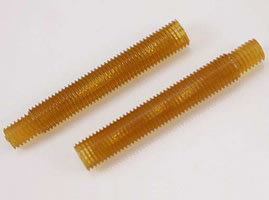 |
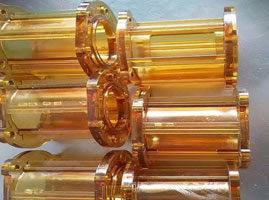 |
Secondary Operations
1. Welding includes Ultrasonic Welding, Vibration Welding, Laser Welding;
2. Printing includes Hot Stamping/Decal, Silk-Screen Printing, Tempo Printing, Laser Engraving, Label Application;
3. Painting and texture;
4. Assembly with other fittings;
5. Customized packaging;
6. Provide certification like RoHS, Reach, CE...
Get more about plastic product